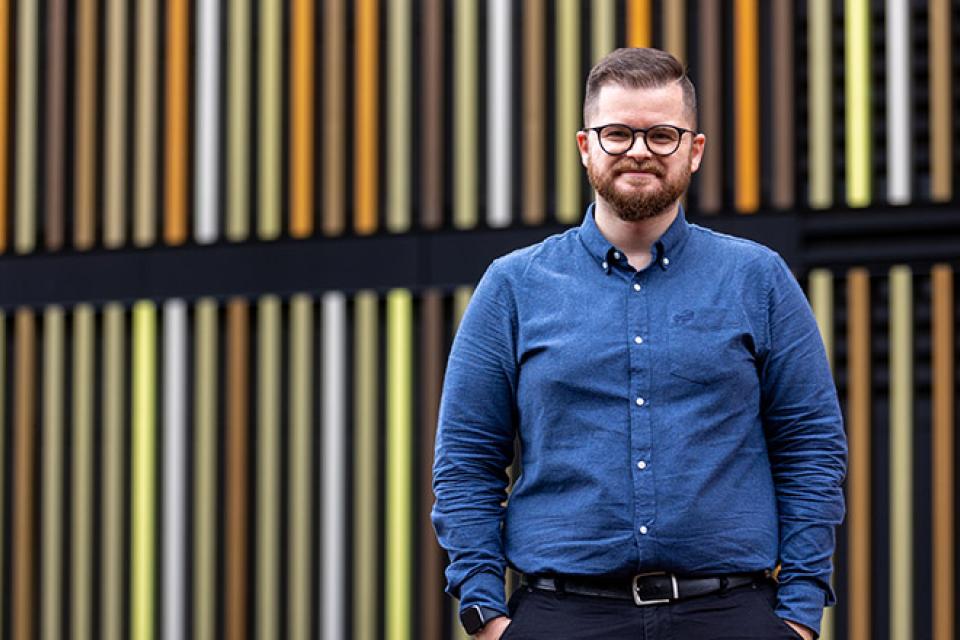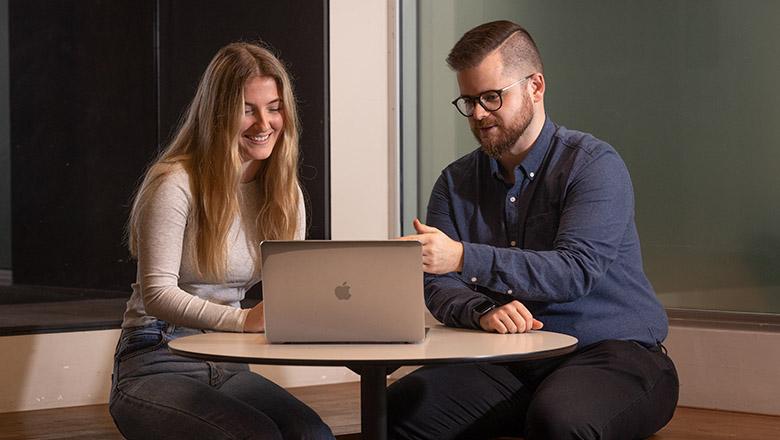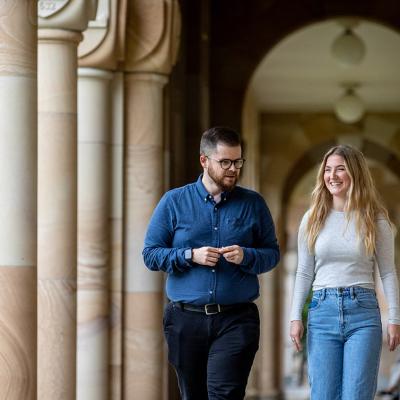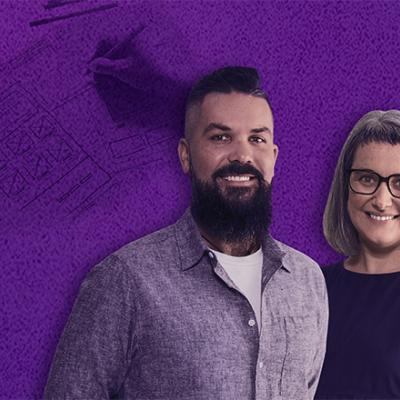When many people think of design, they tend to focus on the end result – impeccably colour-coordinated rooms, shiny new products or detailed illustrations. But according to UQ Associate Lecturer Dr Sean Peel, the most important aspect of design is the process of finding problems.
Yep, you read that correctly. In design, problem-finding is perhaps even more important than problem-solving. After all, how can you create the most impactful solution without first fully understanding the issue at hand?
Sean has dedicated his career as a designer to this pursuit of finding the right problems to solve – the ones that will create meaningful change in the lives of others.
Find out how Sean shares this approach with UQ’s Bachelor of Design students and why he’s so passionate about design as a means of addressing genuine human needs.
Why design?
Sean began his undergraduate studies in industrial design, which looked closely at how humans interacted with products, services and systems.
“I wanted to marry art and creativity with something a little more tangible and directed – that was essentially what brought me to industrial design,” he says.
"However, during my studies, I quickly developed an appreciation for design as a tool for learning about people and about myself, as well."
After graduation, Sean took up a position in design for surgery.
“I worked with cranio-maxillofacial surgeons to create 3D printed models of human anatomy and progressed to developing 3D printed implants to fix that anatomy when someone had a disease, congenital defect or traumatic accident,” he says.
Sean went on to complete a PhD in this area of research but has since come back to teaching design in a more general context.
"What I love about user-centred design and experience design is that it can help people to live more comfortable, fulfilled, or happier lives.”
And what keeps him interested in the field? The fact that good design can be integral in surprising places and scenarios.
“Good design considers psychological, aesthetic, technological, societal, and cultural perspectives, and so the process is rarely dull.”

Design as a systematic approach
Sean believes that for the field of design to continue evolving and adding value to society, it needs to focus on a solid systematic approach to finding and solving problems, rather than relying on serendipitous moments of creative brilliance.
“The design process involves phases related to contextual research, problem analysis, framing of intent, ideation, prototyping, testing, development, implementation, and evaluation,” says Sean.
“If designers are to develop their discipline in the long term, and if solutions are to be linked to genuine human needs, the emerging generation must be adept at gathering evidence, documenting their decision-making, and translating their methods to novel contexts."
Sean’s reasoning? These systematic processes are already used in highly regulated professions – surgeons would always look at a problem with this approach, considering it from all angles. Designers may be working with fewer constraints (and most likely a person’s life will not be at stake) but why should the process be less stringent, if we want to find the most effective solution?
“By becoming expert synthesisers between the details of human needs, stakeholder aims, technological capabilities, ethical motivations, and governmental policies, designers can describe problems in high definition,” says Sean.
“It is this understanding which is the essential pre-requisite for good solutions.”
Design for meaningful change
Alright, so we’ve talked about design using a scientific approach – but what happens when it doesn’t?
Sean outlines that design which doesn’t properly consider the problem it’s trying to solve (by failing to go through a stringent design process) may offer a short-term solution but can end in a lot of pollution or waste.
Take the iPhone, for example. A new version is released pretty much annually, but there’s rarely a significant user need being met. Do we really need this many versions? Surely, if we looked at all the problems and really drilled down into them to analyse these from all angles, we could design one phone that simply lasted and worked.
Obviously, there’s other factors at play here, including marketing, consumerism and profit. However, with the UN predicting that e-waste will increase to 70 million tonnes per year by 2030, prioritising good design is going to be integral to the welfare of the planet in the years to come.
“Technology for technology’s sake can be replaced by a more targeted and justified use of resources,” says Sean.
Sean keeps coming back to this motivating factor in his work – using design to identify problems and provide solutions that create meaningful change. So, what kind of meaningful change is Sean working on right now?
Improving patient experiences through design
Much of Sean’s experience stems from design for medicine and healthcare, and he’s worked on some pretty exciting and life-altering projects.
“At the moment, I’m working on a design and research project which is looking to understand and improve the lived experience of patients who have suffered from heart failure, but who are unsuitable for, or who have not yet found, a heart transplant,” says Sean.
“In place of a donor organ, biomedical engineers and cardiologists have developed remarkable pumps which can replace the heart.”
Sean’s research focuses on using design to improve the patient experience of using this artificial heart.
“It’s a perfect example of a medical product which has huge scope for experiential improvement,” he says.
“The technological achievement is significant, but the day-to-day interactions between patient and device can still contribute to stress, frustration, and dread.”
Sean explains that this can often be the case with medical devices and services – they undoubtedly save people’s lives, but the experience of using them can still cause patients trauma, and he wants to help change that.
“By speaking to patients about their emotional reactions to the devices at a granular level, we are finding promising new routes to making their journey less disruptive.”

Sean’s experience teaching design
When we ask Sean about the challenges and rewards of teaching design, he’s quick to acknowledge the irony of what he does.
“Teaching design requires practising what I preach – designing a course is a design project,” he says.
Sean admits that it can be tricky to put himself in a 17- or 18-year-old’s shoes and find the best approach that will help them to really engage with the topics he covers in his course, Design: Experience. But like the design process, it’s a challenge he’s eager to work through.
“I enjoy challenging myself to find better and more accessible ways to convey a given idea, be it through using examples from my own work, or examples from elsewhere in the media.”
At the core of it, what Sean finds most rewarding is helping students realise that they can use design to understand human experiences and create positive change.
“By equipping students with processes and tools for generating real insights into the experiences of other people, I aim to help them develop and trust in their abilities to empathise with people who might be in very unfamiliar situations, with different abilities, and with divergent motivations to their own.”
It’s this approach that ultimately leads to a better understanding of the problem (especially in the context of health and medicine) and how we can design the best possible solution.
So, what makes a good designer?
Sean gives us an honest rundown of what you need to thrive in a career as a designer, and unsurprisingly, he isn’t solely concerned with skills in sketching, computer-modelling or selecting the correct coloured post-it notes.
Here are the skills and attributes he looks for in his students:
- excellent attention to detail and a willingness to abandon ideas to start again on more justified paths
- a level of comfort with complexity and ambiguity
- excellent communication skills (spoken, written and visual), including the ability to tell a story about problems, projects, and solutions.
Think you’ve got what it takes to pursue a career in design?







